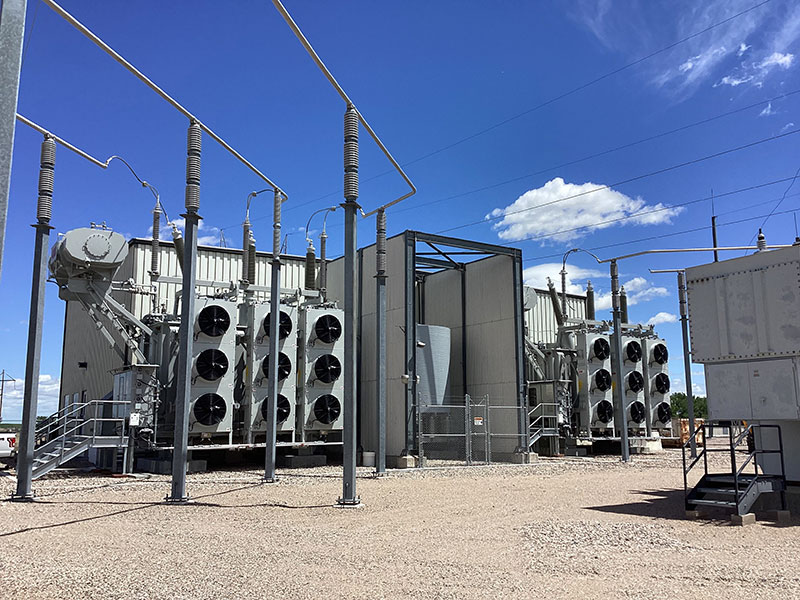- Products
- About
- Responsibility
- Environment
- News
- Contact us
- Careers
-

Running down the center of the United States transmission system lies the East-West divide, or where the eastern and western electrical grids meet. Electricity cannot move between the two asynchronous grids, and as a solution, facilities known as “HVDC interties” or DC ties are placed along the divide. A DC tie takes alternating current electricity, converts it to direct current electricity, and then converts it again to alternating current before sending it onto the power grid. By this means, the need for the alternating current to be synchronized is removed.
There are four DC ties located within Basin Electric’s service territory at Miles City, Montana; Rapid City, South Dakota; Sidney, Nebraska; and Stegall, Nebraska.
In March, Basin Electric took on the maintenance of the DC tie in Stegall, a first for Basin Electric.
JP Maddock, Basin Electric manager of Regional Transmission Organization/Delivery Services, said each DC tie is operated by a Transmission Operator. “Basin Electric is not a Transmission Operator but has a lease agreement with Tri-State Generation and Transmission Association (Tri-State G&T), which is both a Transmission Operator and a Basin Electric Class A member,” Maddock said. “Through our lease agreement, we are responsible for providing operations and maintenance for the Stegall DC tie. Until now, Basin Electric had contracted with Tri-State G&T to perform the operations and maintenance, but Tri-State G&T has opted to turn over the operations and maintenance to Basin Electric.”
Tri-State G&T is also in the process of turning over the role as Transmission Operator. Maddock said Basin Electric is working with another Transmission Operator — Western Area Power Administration Upper Great Plains — to potentially take on that role later in 2024.
DC ties play an important role for Basin Electric, which serves members in both the eastern and western grids, and has generation facilities on both sides as well. “The only way to move power from one interconnect to the other is to use a DC tie. The DC ties help Basin Electric utilize generation capacity from one interconnect and move it to the opposite to provide power to our members. The DC ties allow Basin Electric to use resources to serve member loads in opposite interconnects. If there is excess generation in one interconnect, and a third party needs power in the opposite interconnection, the DC ties allow for Basin Electric to utilize and optimize excess generation and make sales to entities in need across the interconnect,” Maddock said.
“Also, in the event that Basin Electric has a resource that goes on outage in either interconnect, having the ability to move power from one interconnect to the other to back fill Basin Electric’s power supply obligations, commitments, or positions that had previously been made is beneficial for Basin Electric to cover itself,” he said.
Three employees at the Stegall DC tie transferred from Tri-State G&T to Basin Electric. Derik Johnson, Basin Electric manager of Transmissions System Maintenance, said having those technicians on site at Stegall has helped smooth the transition for Basin Electric taking over maintenance.
“Essentially, the Stegall DC tie location adds another shop location to our Transmission Systems Maintenance fleet [Transmission Systems Maintenance managed 11 shops across the cooperative's service area, and now manages 12 shops.], which is being incorporated into the Basin Electric system,” Johnson said. “The crew at the Stegall DC tie are working continuously to maintain discreet components like resistors, diodes, electronics they physically solder onto boards. Everything is either repaired or reengineered by this team.”
Mark Soper, Basin Electric lead systems protection technician, is part of the team who works at the DC tie at Stegall. He said despite a lot of recent upgrades, the tie is rooted in the last century. “It is like maintaining a vintage car — the technology at the Stegall tie is technology from the 1970s and our job is to keep it running,” Soper said.
Soper said the Stegall DC tie was built using solid state technology that was new in the 1970s when the tie was built. “Prior to that, they used mercury arc valves, like those you used to see in the back of old televisions, but on a larger scale,” he said. “The newer thyristor technology is the bread and butter of the DC tie; it is what turns the electricity from AC-DC-AC. Thyristors are similar to a diode but have a gate that is controllable. I have a lot of respect for the engineers who designed and built this almost 50 years ago, and for all the technicians who have maintained its more than 99% reliability record.”
Dakota Gasification Company
Headquarters:
1717 East Interstate Avenue | Bismarck, ND 58503-0564 USA
701.223.0441 | 1.800.242.2372
Great Plains Synfuels Plant
420 County Road 26
Beulah, ND 58523-9400 USA
701-873-2100
A subsidiary of:
Basin Electric wants all interested and qualified candidates to apply for employment opportunities. If you are an applicant with a disability who is unable to use our online tools to search and apply for jobs, or who needs other assistance or accommodations, please contact us at 701-223-0441. Please indicate the specifics of the assistance needed or provide your contact information, and a Basin Electric Human Resources representative will contact you. Basin Electric is an Equal Employment Opportunity Employer regarding race, color, religion, sex, sexual orientation, gender identity, national origin, disability, and veterans status.